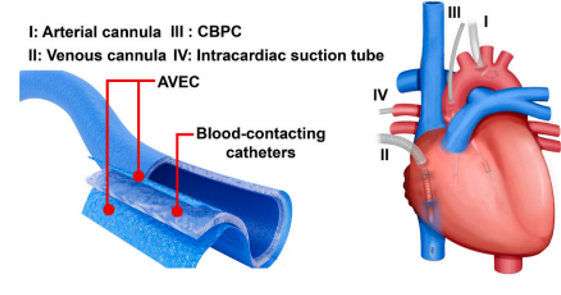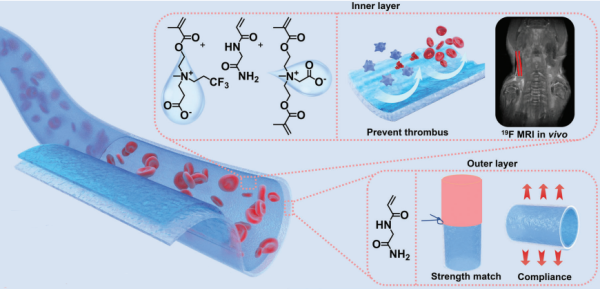Arteriosclerotic vascular disorders are one of the most common causes of death in industrialized countries. Blockage of blood vessels can quickly become fatal, and in these situations a bypass operation to replace a clogged blood vessel either with another vessel taken from elsewhere in the patient’s body, or even by an artificial vascular prostheses, is often the only solution, however, it is highly probable that this can triggers re-trauma and complications. Therefore, how to make the small-diameter vascular grafts (SDVGs) meet the clinical standard, thus addressing its safety issues, is a worldwide urgency.
Now, scientists from Asia have made a breakthrough in the field of artificial vascular endothelium coating (AVEC) and small-diameter vascular grafts (SDVGs). The team has developed a bilayered hydrogel tube based on the essential structure of native blood vessels as an artificial SDVG by optimizing the relation between vascular functions and the molecular structure of hydrogels.


The inner layer and out layer of the SDVGs
The inner layers of the SDVGs comprised a zwitterionic fluorinated hydrogel, fundamentally avoiding the formation of inflammation-induced mural thrombi. The paper “Bioinspired, anticoagulative, 19F MRI-visualizable bilayer hydrogel tubes as high patency small-diameter vascular grafts” has been published in the international journal Small.
Artificial vascular endothelium coating fundamentally avoids the formation of thromboinflammation-induced mural thromb.
Cardiovascular disease is now the number one cause of death globally according to the World Health Organization, with more than 17.5 million patients dying from it every year. Coronary artery bypass grafting is one of the most effective approaches for treating severe cardiovascular disease. However, patients undergoing the procedure still face high risks of transplantation surgery failures and potential complications caused by compliance mismatch of Cardiac interventional biomaterials. Most of our accepted biomaterials today (e.g., Teflon, Dacron) trigger foreign body reaction (FBR). The FBR reaction, if mild, is accepted by medical device regulatory agencies. However, the case is made that the FBR is really a manifestation of chronic inflammation—an ongoing, unending attack against the biomaterial. The biomaterial essentially never truly heals in the body. Thus, so-called biocompatible biomaterials are perhaps not so biocompatible! This ongoing inflammation inhibits the formation of a healthy endothelial cell layer and the rigid foreign body capsule prevents the normal flexing pulsation of an implanted graft. Grafts showing the FBR are poised to fail because they do not have a healthy, living endothelial lining and their non-flexing walls and capsule contracture reduce blood flow and produce flow disturbances which lead to thrombosis.
According to reports, the intima layer of natural blood vessels is composed of endothelial cell layer and longitudinal elastic fibers and connective tissue around it, which is the best blood compatibility surface. Submicron-scale grooves along the long axis of blood vessels are distributed on the surface of intima, and there are nano-scale package protrusions on the surface of the grooves. Endothelial glycocalyx (a hydrated layer formed on the surface of the tunica intima) ensures the smooth structure of the blood vessels’inner surface and provides a good dynamic environment for blood flow.
The research shows that the micron topology on the surface of vascular intima can effectively inhibit the adhesion of platelets. “By simulating the structure of vascular intima, we have constructed a zwitterionic polymer hydrogel coating with simple process and excellent performance, which has a very low friction coefficient similar to that of vascular intima and a smooth surface without blood disturbance.” said Li Shuangyang, a doctoral student in this team and the first author of this article. He noted that they achieved “zero adhesion” of platelets by using this gel coating.
The team coated the hydrogel on the inner surface of the cardiopulmonary bypass pipeline, and performed the cardiopulmonary bypass experiment on pigs to observe the platelet adhesion inside the pipeline after cardiopulmonary bypass and the results showed that there was no platelet adhesion in the pipeline. In conclusion, the hydrogel coating prepared by the team can effectively inhibit the adhesion of platelets during the external circulation.

Pig experiments prove that the function of the coating is excellent
This research in the anticoagulant coating laid the foundation for the team to develop small-diameter vascular grafts.
Media Contact
Company Name: Lingrong Culture
Contact Person: Wang Yurong
Email: Send Email
Phone: 2134007851
Address:3185 Wilshire blvd
City: Los Angeles
State: CA
Country: United States
Website: www.lingrongculture.com
